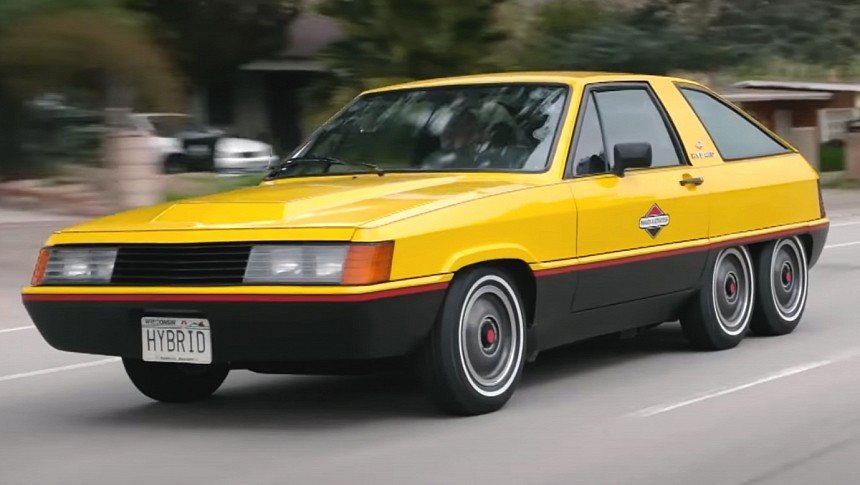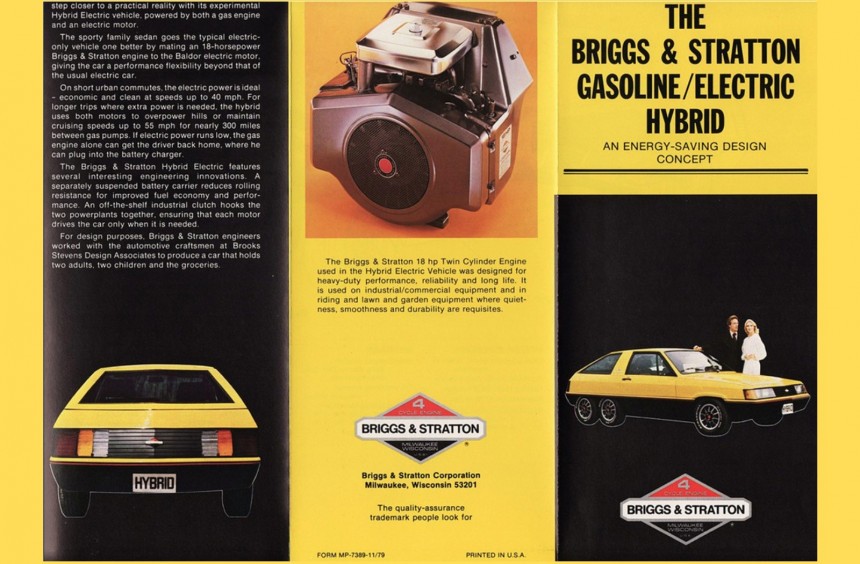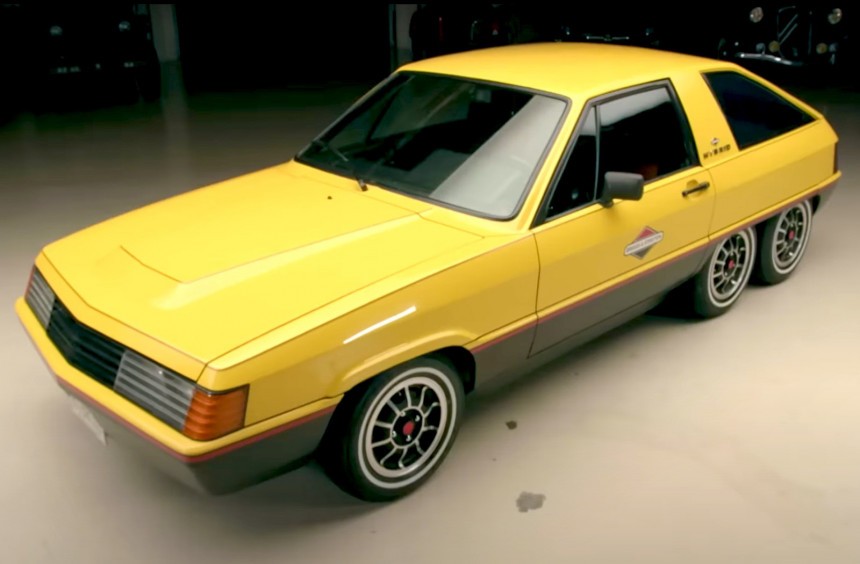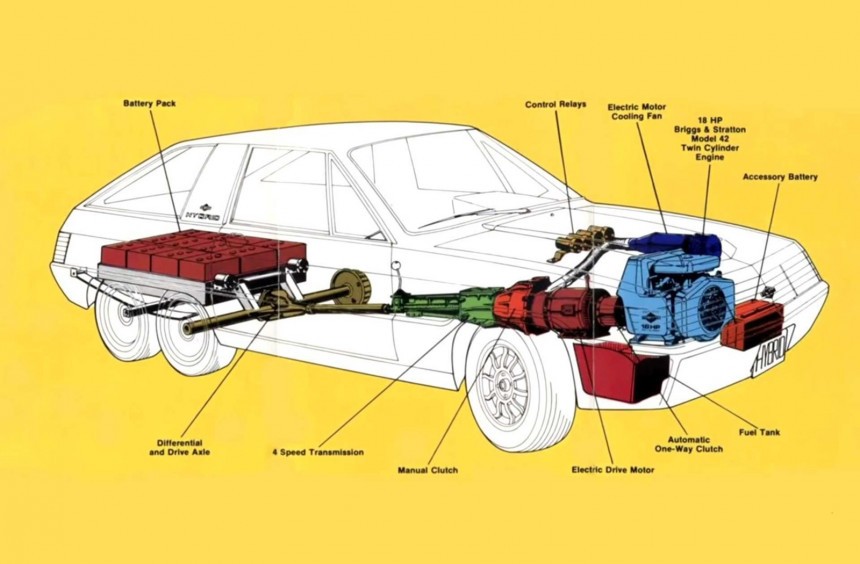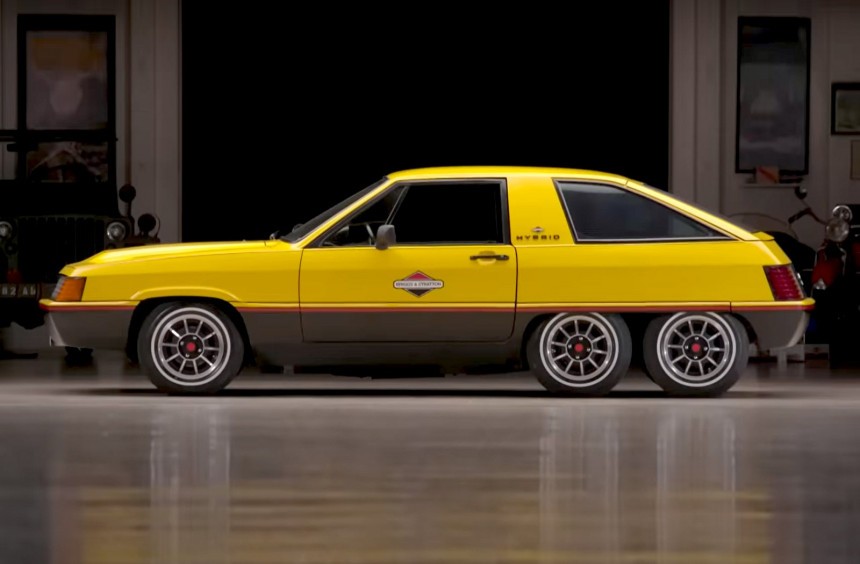After two fuel crises that plagued the automotive industry during the 1970s, American manufacturers started experimenting with fuel-efficient technologies. One of the most exciting prototypes was this six-wheeled hybrid that combined a lawnmower ICE with a battery-electric system.
The concept of a hybrid-electric vehicle (HEV) is a 21st-century affair to most people. However, the first HEV prototypes came into being as early as 1889.
Most historians credit a couple of designs by William H. Patton as the first HEV systems ever put together, but these were meant for rail cars and boats.
The first automobile to use a hybrid system was unveiled in 1900, and it was a Porsche. Well, sort of. Three decades before Porsche officially became a carmaker, its founder, Ferdinand Porsche – who at the time was an ambitious 25-year-old engineer working for Lohner Coach Factory in Vienna, Austria – developed a hybrid prototype nicknamed Semper Vivus, which entered production a year later as the Lohner-Porsche Mixte.
In the United States, the fossil fuel magnates encouraged ICE development, but several engineers worked on electric and hybrid systems for decades. However, such projects would receive serious interest once the aforementioned fuel crises hit the industry hard during the seventies.
There was one exception built during the late sixties called XP 512. It was a small hybrid concept developed by General Motors, which was presented to the public in 1969, but since that was an era when the market had a keen interest in gas-guzzling, V8-powered muscle cars, it was quickly forgotten.
In 1973, the first oil crisis of the decade ended the development of high-horsepower muscle cars. Then, six years later, the Iranian Revolution kicked off another severe energy crisis that sent shockwaves throughout the automotive industry.
During that time, a manufacturer of small internal combustion engines based in Wauwatosa, Wisconsin, started developing one of the era's most fascinating hybrid cars.
Called Briggs & Stratton, the company founded in 1908 was (and still is) known for producing small engines, predominantly air-cooled twin-cylinders, that saw use in generators of lawnmowers.
But during the late-seventies, management decided that the company's technologies could be used to create a fuel-efficient passenger car, so much to everyone's surprise, Briggs & Stratton developed one.
The bulk of Briggs & Stratton's hybrid prototype was based on a first-gen Volkswagen Scirocco, the sleeker and sportier cousin of the legendary Golf (known as Rabbit in the US).
While components like the doors, windshield, side windows, and interior were carried over from the Scirocco, Briggs & Stratton's crew had to fabricate most of the other body panels, like the entire front and rear ends, from scratch, using fiberglass. Much of the custom work was designed by Brooks Stevens, the legendary American stylist responsible for many great American vehicles, including the 1949 Harley-Davidson Hydra-Glide or the original Jeep Wagoneer.
The chassis was also extensively modified, borrowing parts like the steering rack, front disc brakes, and front suspension from the tiny Ford Pinto.
The project aimed to showcase that a car could cruise at the national speed limit of 55 mph (88.5 kph) using a small ICE coupled with an electric motor and reach a fuel efficiency of 30 mpg (7.8 liters per 100 km).
To do that, the company's engineers equipped it with an air-cooled and carburated flat-twin engine rated at only 18 hp. This was the kind of unit that could be found in lawnmowers, and with a displacement of 694 cc (42 cubic inches), it was almost as small as the air filters of the era's underpowered V8s.
Between the Model 42 engine and the four-speed manual from the Pinto, engineers placed a fan-cooled electric motor fed electrons by a 72-volt battery pack. Unlike modern EVs, which use lithium-ion batteries, the Briggs & Stratton Hybrid concept's pack comprised twelve 6-volt lead-acid batteries that were similar in size and weight to conventional starter batteries.
Since the pack couldn't be integrated into the vehicle's floor, as we see on modern EVs and hybrids, they had to be placed in the trunk, which put a considerable strain on the rear axle. Engineers added a second axle to support the battery pack's enormous weight, so the concept became a six-wheeler.
The concept was unveiled to the public in 1980, with NASCAR legend Richard Petty showcasing its capabilities on a closed circuit.
Briggs & Stratton wanted to show the world that building a fuel-efficient passenger car with a hybrid powertrain was possible but never considered mass-producing it.
It remained in the company's possession, receiving regular maintenance to keep it functional, and throughout the years, it made several appearances at auto shows. It was also featured in many magazines and TV programs, where it was dubbed one of America's first fully-functional HEVs. Most recently, it appeared in a Jay Leno's Garage episode, which you can watch below.
Though it was never meant to be mass-produced, the Briggs & Stratton Hybrid six-wheeler remains one of the most intriguing concept cars of the 1980s.
Most historians credit a couple of designs by William H. Patton as the first HEV systems ever put together, but these were meant for rail cars and boats.
The first automobile to use a hybrid system was unveiled in 1900, and it was a Porsche. Well, sort of. Three decades before Porsche officially became a carmaker, its founder, Ferdinand Porsche – who at the time was an ambitious 25-year-old engineer working for Lohner Coach Factory in Vienna, Austria – developed a hybrid prototype nicknamed Semper Vivus, which entered production a year later as the Lohner-Porsche Mixte.
In the United States, the fossil fuel magnates encouraged ICE development, but several engineers worked on electric and hybrid systems for decades. However, such projects would receive serious interest once the aforementioned fuel crises hit the industry hard during the seventies.
From lawnmower engines to one of America's first hybrid cars
In 1973, the first oil crisis of the decade ended the development of high-horsepower muscle cars. Then, six years later, the Iranian Revolution kicked off another severe energy crisis that sent shockwaves throughout the automotive industry.
During that time, a manufacturer of small internal combustion engines based in Wauwatosa, Wisconsin, started developing one of the era's most fascinating hybrid cars.
Called Briggs & Stratton, the company founded in 1908 was (and still is) known for producing small engines, predominantly air-cooled twin-cylinders, that saw use in generators of lawnmowers.
But during the late-seventies, management decided that the company's technologies could be used to create a fuel-efficient passenger car, so much to everyone's surprise, Briggs & Stratton developed one.
A combination between a VW Scirocco and a Ford Pinto
While the company's designers and engineers had the required know-how to develop an innovative hybrid powertrain, they had yet to attempt to manufacture a passenger car, so they had to improvise with existing components.
The bulk of Briggs & Stratton's hybrid prototype was based on a first-gen Volkswagen Scirocco, the sleeker and sportier cousin of the legendary Golf (known as Rabbit in the US).
While components like the doors, windshield, side windows, and interior were carried over from the Scirocco, Briggs & Stratton's crew had to fabricate most of the other body panels, like the entire front and rear ends, from scratch, using fiberglass. Much of the custom work was designed by Brooks Stevens, the legendary American stylist responsible for many great American vehicles, including the 1949 Harley-Davidson Hydra-Glide or the original Jeep Wagoneer.
The chassis was also extensively modified, borrowing parts like the steering rack, front disc brakes, and front suspension from the tiny Ford Pinto.
Why six wheels?
To do that, the company's engineers equipped it with an air-cooled and carburated flat-twin engine rated at only 18 hp. This was the kind of unit that could be found in lawnmowers, and with a displacement of 694 cc (42 cubic inches), it was almost as small as the air filters of the era's underpowered V8s.
Between the Model 42 engine and the four-speed manual from the Pinto, engineers placed a fan-cooled electric motor fed electrons by a 72-volt battery pack. Unlike modern EVs, which use lithium-ion batteries, the Briggs & Stratton Hybrid concept's pack comprised twelve 6-volt lead-acid batteries that were similar in size and weight to conventional starter batteries.
Since the pack couldn't be integrated into the vehicle's floor, as we see on modern EVs and hybrids, they had to be placed in the trunk, which put a considerable strain on the rear axle. Engineers added a second axle to support the battery pack's enormous weight, so the concept became a six-wheeler.
It looked goofy, but it worked
While it was essentially an RWD car with a four-speed manual, the Hybrid concept could start and be driven for 40 to 60 miles (64-96 km) solely on electric power. The electric motor could be enabled or disabled by the driver at any time using a dashboard-mounted knob, and when working with the small ICE, it could propel the 3,200-pound (1,451-kg) vehicle to a cruising speed of up to 68 mph (109 kph).
The concept was unveiled to the public in 1980, with NASCAR legend Richard Petty showcasing its capabilities on a closed circuit.
Briggs & Stratton wanted to show the world that building a fuel-efficient passenger car with a hybrid powertrain was possible but never considered mass-producing it.
It remained in the company's possession, receiving regular maintenance to keep it functional, and throughout the years, it made several appearances at auto shows. It was also featured in many magazines and TV programs, where it was dubbed one of America's first fully-functional HEVs. Most recently, it appeared in a Jay Leno's Garage episode, which you can watch below.
Though it was never meant to be mass-produced, the Briggs & Stratton Hybrid six-wheeler remains one of the most intriguing concept cars of the 1980s.
